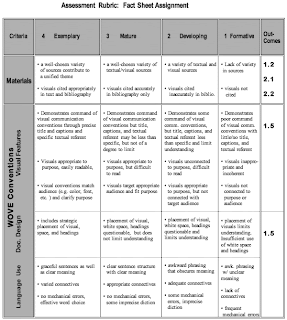Exercise : Evaluation Rubrics
Introduction
Among the ancients, according to Columella, Vitruvius, and Pliny, the word rubrica, or rubric, signified the red earth used by carpenters to mark on wood the line to follow when cutting it; according to Juvenal the same name was applied to the red titles under which the jurisconsults arranged the announcements of laws. Soon the red colours, at first used exclusively for writing the titles, passed to the indications or remarks made on a given text.1
Today in academia we refer to a rubric as a scoring tool rather than as it was originally referenced: notes in red ink used in grading text. We maintain the spirit of the original meaning of rubric since the term still refers to a general rule or guide for judging something of importance. More specifically, a scoring rubric consists of a fixed scale and a list of the characteristics for describing performance for each of the score points on the scale. Since rubrics describe levels of performance, they provide important information to teachers, parents and others interested in what students know and are able to do. Perhaps most importantly, rubrics provide a clear statement to students, teachers and parents as to what is considered important and worth learning, even before the learning has occurred because "once educators incorporate multiple intelligent strategies into the teaching repertoire, it becomes important to rethink the approach to assessment." 2.
"If you get something wrong, your teacher can prove you knew what you were supposed to do
What would you include in the basic criteria for doing research?
Authority: Decide whether an individual, an organization or an agency who is recognized as an expert in a field who is knowledgeable, qualified and reliable.
- Authors qualifications and affiliation: Is the author or information provider clearly identified? Is the data included about the author?
- Is there a contact person or address available: Can the webmaster be contacted easily?
- Is there evidence of quality control? Is information presented on an official organizational web site; online journals that use peer review by editors or others; posting of information taken from books or journals that previously underwent a quality control process.
Accuracy: Can it be verifiable, dependable and error-free?
Motivation: Is the author supplying real, measurable information or is he or she just trying to sell an idea or opinion?
Objectivity: Is the material presented selectively or in a unbalanced manner which is only one side of an issue, or was some information left out? Is the information merely an opinion on an issue? To what extent is the creator trying to change our own opinion?
Currency of Information: Relates to the date of information, publication date or date of last revision. As in printed sources, some work is timeless, like classic novels or much of history. Other work has limited life because of changes in the discipline like technology. Up to date links add to the validity of the entire site.
Grading Rubrics
The ANGEL LMS' grading rubrics simplify the process of grading manually graded items and assure that students are evaluated against the same criteria by the same or multiple graders. Rubrics further strengthen ANGEL’s support for a learning outcomes approach. By aligning rubrics to standards and/or objectives, institutions can measure student progress against goals.
Rubric Characteristics
Grading rubrics provide the following capabilities to instructors:
- Simple creation – create rubrics using a simple three-step process.
- Alignment to standards – align to or copy grading rubrics from system standards.
- Consistent evaluation – define specific criteria and achievement levels to evaluate all submissions against the same set of criteria.
- Point-and-click grading – score student's work by simply clicking in the cell that corresponds to their level of achievement for a particular criteria. The rubric calculates the score based on the point value of the assignment. An instructor can override any point value.
- Sharing – reduce rework by sharing rubrics in or across departments through the learning object repository. Instructors can browse and preview all shared rubrics when creating an assignment.
Collaboration Rubric
Evaluation Rubrics
http://faeriekeeper.net/criteria38.htm


No comments:
Post a Comment